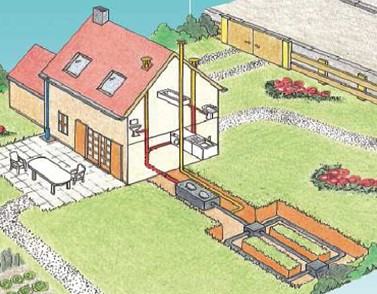Unerstanding Septic Tanks (a little better)

Since 2011 house sellers are required to have a survey of their septic tank undertaken prior to sale. This means that if the property has a septic tank, the Contract of Sale must include a “diagnostic d'assainissement non collectif”. Indeed if the property is on mains drains a report is still required to confirm that the property is correctly connected.
The report will form part of the Dossier de Diagnostic Technique (DDT) - the House Information Pack of documents that has to be prepared by all sellers. We will run through and explain all these reports to you so that you are clear of their content.
If the system is later shown not to comply with regulations, then the new owner will be ‘obliged’ to bring it up to standard within 12 months of completion. This said we have NEVER known of a re-inspection taking place to confirm that the suggested works have been carried out.
Understanding your system is important. A typical system takes all the waste water from your bathrooms, toilets and kitchen to a 'fosse toutes eaux'. If this is more than 10m from your house there should be a ‘bac degraisseur’ (grease trap) between the house and the 'fosse'. From the 'fosse', the water is piped to a filter bed or filtering land drain depending upon your ground conditions. From the filter bed, clean water will be drained into the land or piped into a ditch.
The system will also have ventilation pipes to avoid odours and pollution. The primary ventilation is taken from the WC downpipe straight through the roof; secondary ventilation evacuates the noxious gases (hydrogen sulphide and methane) generated by the bacterial action inside. It’s taken from the top of the fosse, or the outlet pipe, and vented to an outside wall of a nearby building, generally to above the eaves.
Maintaining your septic tank:
You must ensure that the bacterial activity of your septic tank is replenished regularly by using a top quality product such as Eparcyl readily available in the local supermarket. I have even heard a story of an old French madame throwing the odd dead rabbit into the septic tank to get the bacteria going! You may want to weigh up the pricing of dead rabbits vs Eparcyl type products beforehand. Bio-active yogurts are also meant to work!!!
Secondly, try to avoid using too many chemicals such as bleach, disinfectants etc. as this will kill off much of the hard-working bacteria in your tank. It is the bacteria which break down the ‘sludge’ (to use a finer word) within the tank and so bacteria are your friend.
Every 4 months do a visual check of your system or even better ask a good friend to do so. When the ‘sludge’ content of your septic tank is more than 2/3 of the total volume pump out a third to half of the sludge. Never empty your tank completely. Apparently a septic tank without any sludge in it will not work well and will start to smell. 20 to 30 % of the ‘sludge’ must remain in the tank at all time. It can take up to a year for an emptied tank to get back to normal.



